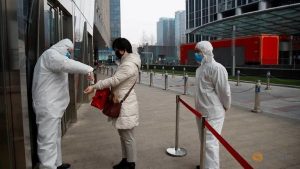As the original epicentre of the COVID-19 outbreak, China was the first to impose a strict lockdown on millions of its residents. Business is almost as usual for some companies now – albeit with precationary measures to prevent new infections. Money Mind reports.

A worker checks the temperature of a woman as she enters an office building in the Central Business District in Beijing as the country is hit by an outbreak of the novel coronavirus, China February 24, 2020.
SINGAPORE: Around the world, many countries are starting to ease restrictions after months of economically stifling lockdowns to curb the spread of COVID-19.
As the original epicentre of infection, China was the first to impose a strict lockdown on millions of its residents.
Many of its enterprises are now back at work, and their experience of the “new normal” could provide lessons for other countries around the world.
In the southern city of Suzhou, it is almost business as usual for Manuli Hydraulics.
After a three-week shutdown, operations sprang back to life in mid-February.
The hydraulic solutions manufacturer is now operating at full capacity, but not before making sure that safety precautions were in the pipeline.
“When we got back to work, our production rate was was quite low, not more than 40 per cent mainly because a lot of people were still stuck in the native villages where they head to during Chinese New Year,” said Mr Luca Pozzi, general manager for China and Southeast Asia at Manuli Hydraulics.
“But then progressively, people start to get back and by beginning of March we reached 90 per cent of capacity,” he said.
Factory employees are now required to submit a daily health declaration and go through a health screening before they enter the premises. Their temperature is taken, and masks, safety goggles and gloves are compulsory.
All forms of face-to-face interaction have been banned, and meetings take place on online platforms.
Cleaning protocols have also been stepped up.
The additional measures have not slowed down production, said Mr Pozzi, adding that they instead enable employees to both continue working and remain safe.
“There is a way to work in total protection,” said Mr Pozzi.
“Cleaning is just an operation that takes a few minutes for each office. These are operations that are not affecting, neither the production, nor impacting our result in term of income,” he said.
Having maintained a healthy inventory before the coronavirus crisis also meant that Manuli Hydraulics could restart production quickly.
The company usually keeps at least three months’ worth of inventory for its production materials and was able to resume operations even if its suppliers were completely shut down.
For smaller firms, however, the crisis has taken a toll on their supply chains.
The supply chain is only as strong as the weakest link in the chain, said Karel Eloot, senior partner at McKinsey & Company in Shanghai.
“There’s a very different impact of COVID-19 on different sizes of companies. Large companies are more robust. But at the other end, and that’s where the suppliers are, they are typically smaller and medium sized enterprise and these companies we have seen are more vulnerable to the impact of this crisis,” he said.
Smaller companies are more susceptible to cash flow issues during a crisis and may not be able to get access to enough bridge funding. As a result, they are more susceptible to business failure, he said.
Away from the manufacturing space, retail and food and beverage outfits have also been forced to change the way they operate.
Ms Jessie Qian, head of consumer and retail at KPMG China, said that the pandemic sparked changes in consumer behaviour that in turn hastened business transformation, particularly around digitalisation.
Retailers will now need to change the way they think about their customers, said Mr Eloot.
While cleaning and social distancing measures are likely to increase operational costs, retailers could have an even bigger challenge.
Footfall at malls was severely affected during the lockdown, and it might take some time for demand to return to previous levels.
The crisis is also forcing retailers to think about longer term challenges and transformation.
As companies get back to work, experts said, it is important to manage expectations.
“In the near term, rethinking the cost of doing business will become very important. Cashflow management, product optimisation and a supply chain review – all this will help a company to survive and stay competitive during the COVID-19 pandemic and during the recovery stage,” said Ms Qian.



